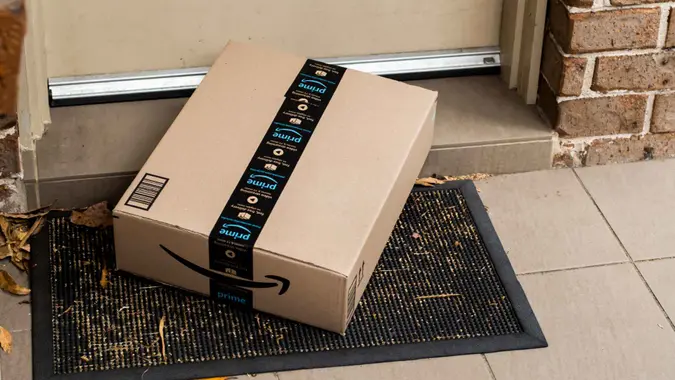I’m a Middle-Class American: Here’s My Monthly Budget

Commitment to Our Readers
GOBankingRates' editorial team is committed to bringing you unbiased reviews and information. We use data-driven methodologies to evaluate financial products and services - our reviews and ratings are not influenced by advertisers. You can read more about our editorial guidelines and our products and services review methodology.

20 Years
Helping You Live Richer

Reviewed
by Experts

Trusted by
Millions of Readers
Rising prices have constricted many Americans’ budgets, with a recent GOBankingRates survey finding that 76% tightened their belts due to inflation. While that’s not always easy to do, paying close attention to your income and expenses and making adjustments as needed, can help you stay on track to reach financial goals, like paying off debt, saving for a house, etc.
But what exactly does that budgeting look like? While budgets are specific to your situation — someone in New York might have higher housing costs than someone in Texas, for example — it can help to look at how other people are budgeting. Doing so can give you inspiration for how to structure your budget and get a sense of how other people approach spending
Monthly Budget Breakdown
Here, we’ll take a look at the monthly budget for Alaina Fingal, a financial YouTuber, certified financial coach and owner of The Organized Money. Fingal lives in New Orleans with her husband and two children.
Monthly Income: $8,000
With both her and her husband being entrepreneurs, Fingal’s household monthly income is variable. However, they average around $8,000 per month.
Tithe or Donations: $800
Fingal donates 10% of her income, equaling $800 per month.
Expenses: $6,200
After donations, Fingal’s fixed and variable expenses add up to $6,200, which includes the following:
- Mortgage: $1,460.62
- Student loan: $151.43
- Car note: $539.22
- Life insurance: $182.70
- Air conditioner financing: $500
- Mattress financing: $191
- Miscellaneous fixed expenses, such as utilities and subscriptions: $675.03
- Groceries or toiletries: $800
- Restaurants: $400
- Gas: $250
- Events and entertainment: $200
- Shopping (household items and clothing): $300
- Personal (hair, beauty and kids care): $400
- Miscellaneous or buffer: $150
Savings, Investments or Sinking Funds: $1,000
After donations and regular expenses, Fingal budgets for $1,000 in savings and investments. This also includes money for sinking funds, such as savings buckets that are meant to get spent down, such as if you’re saving for an upcoming expense like vacation or holiday gifts. Currently, Fingal’s budget includes:
- Car insurance savings: $400
- Short-term savings: $400
- Investing: $200
Adjusting to Inflation
Fingal has constructed a budget that enables her family to stay on top of bills while still having some money for fun and savings, but she’s had to make changes recently due to inflation.” I had to adjust my events and entertainment budget from $400 to $200, to accommodate the rising price of groceries,” she said. “We also a couple of years ago, as a family of four, would eat out twice per week. Currently, we have reduced it to only eating out once per week.”
However, food costs are the most difficult area of the budget for her family to stick to, as many Americans can likely relate to.
“We would plan to cook the entire week, but my husband and I are both entrepreneurs and sometimes our schedule would make it challenging for us to cook during the week. Getting better at our meal planning process has definitely helped, but this area has been a struggle,” she said.
Gaining Peace of Mind
While budgeting isn’t always easy, such as when it comes to sticking to a food budget when dealing with time constraints, being diligent with her budget has been a positive for Fingal.
It gives her peace of mind “knowing what bills are paid, what bills are outstanding and being able to prepare for all expenses,” she said.
Plus, budgeting can make it easier to adapt to changes like rising prices and unexpected expenses.
“My budget has helped me with my financial flexibility, and now when we have an unexpected expense, we can adjust instead of becoming fearful or anxious. An unexpected expense is now an inconvenience instead of a disaster,” she said.
Staying on Track
While you might have tried building your own budget to get a handle on your expenses, many people have trouble staying on track.
To combat this, it’s important to find a system that works for you, rather than assuming that one type of tool can work for everyone. For example, if you’ve had trouble keeping up with budgeting apps, you might find that Fingal’s written approach is more up your alley.
“I have used pen and paper for the past 10 years because it has worked well for us. I tried apps in the past but struggled with keeping up with the app. I wouldn’t open the app often and when I finally opened the app, I would become overwhelmed at the process to get the app back on track,” Fingal said.
“With pen and paper, I easily and quickly write down how much I have spent in a day, and I check off bills as they are paid. The simplicity of the system has helped me to stay consistent,” she said.
That’s important, because even if you have a solid budget like Fingal, if you can’t stay on track in terms of making sure you’re sticking to your limits and making adjustments where necessary, then it’s hard to reach your financial goals.
More From GOBankingRates
- Nearly 1 in 3 Americans Hit by a Costly Holiday Scam, Norton Survey Shows -- How To Avoid This
- Here's What Retirees Wasted the Most Money On in 2025 -- and How To Avoid It in 2026
- How Middle-Class Earners Are Quietly Becoming Millionaires -- and How You Can, Too
- 6 Safe Accounts Proven to Grow Your Money Up to 13x Faster
 Written by
Written by  Edited by
Edited by 

























